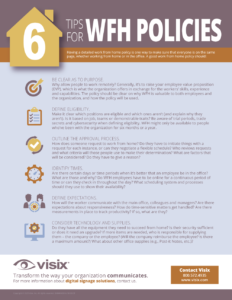Having a detailed work from home policy is one way to make sure that everyone is on the same page, whether working from home or in the office. A good work from home (WFH) policy should:
1. Be clear as to purpose. Why allow people to work remotely? Generally, it’s to raise your employee value proposition (EVP), which is what the organization offers in exchange for the workers’ skills, experience and capabilities. Put plainly, working from home is an option because some people want it, and it enhances their experience with the company. The policy should be clear on why WFH is valuable to both employees and the organization, and how the policy will be used.
2. Define eligibility. Obviously, some positions are better suited to remote work than others. An on-call nurse has to be physically present to assist patients, for example. Make it clear which positions are eligible and which ones aren’t (but also explain why those that aren’t, aren’t). You might even individualize it a bit – employees who can demonstrate reliability and discipline, and can work independently, would be candidates for remote work if their tasks allow for that. Being aware of trial periods, trade secrets and cybersecurity could be another factor to consider. WFH might only be available to people who’ve been with the organization for six months or a year.
3. Outline the approval process. How does someone request to work from home? Do they have to initiate things with a request for each instance, or can they negotiate a flexible schedule? Who reviews requests and what criteria will those people use to make their determination? What are factors that will be considered? Do they have to give a reason? Examples might be:
- Childcare issues
- Commute times
- Illness
- Weather
- Home emergencies
- Improving overall work/life balance
4. Identify times. Are there certain days or time periods when it’s better that an employee be in the office? What are those and why? Do WFH employees have to be online for a continuous period of time or can they check in throughout the day? What scheduling system and processes should they use to show their availability?
5. Define expectations. How will the worker communicate with the main office, colleagues and managers? Are there expectations about responsiveness? How do time-sensitive matters get handled? Are there measurements in place to track productivity? If so, what are they?
6. Consider technology and supplies. Do they have all the equipment they need to succeed from home? Is their security sufficient or does it need an upgrade? If more items are needed, who is responsible for supplying them – the company or the employee? (Will the company reimburse the employee? Is there a maximum amount?) What about other office supplies (e.g., Post-it Notes, etc.)?
There has to be a certain amount of trust built into any WFH policy. Micromanaging virtual workers will certainly impact their efficiency and negatively impact the positive intangibles that working from home can provide. You have to assume they will do their best, and then evaluate if they do. If not, maybe things need to be adjusted. The process isn’t really any different than evaluating the work of an in-office employee.
The way to do this is with various measurement tools, such as KPIs. Hopefully, your organization is already using and sharing them, so adding a couple more for remote work is an easy process. If not, now might be a good time to put some in place. Unless the virtual employee is simply evaluated on a task-by-task basis, being able to see what’s happening becomes even more important when people aren’t in the office every day. And that’s a two-way street – your remote workers will also benefit from having transparency into how they’re doing and what, if anything, needs improvement.
If you follow these tips for your work from home policies, you can eliminate confusion and frustration for both your organization and your WFH employees.
- Want to share some WFH tips with employees? Grab our infographic: 16 Tips for Setting Up a Home Office.

